Dive into the captivating world of the clarinet, where every intricate part plays a harmonious symphony. This comprehensive guide unveils the parts of the clarinet diagram, revealing the secrets behind its enchanting sound and versatile performance.
From the mouthpiece that shapes the air to the bell that amplifies the resonance, each component contributes to the clarinet’s distinct character. Join us on this musical journey as we explore the anatomy of this beloved instrument.
Mouthpiece
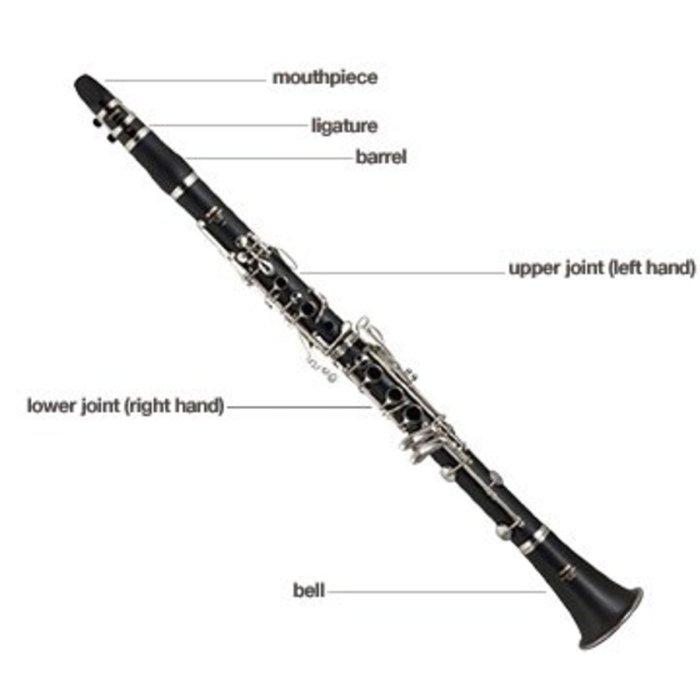
The mouthpiece is the part of the clarinet that the player blows into. It is responsible for creating the sound of the instrument. The mouthpiece is made up of several different parts, including the tip, the facing, the reed, and the ligature.
The tip is the part of the mouthpiece that the player’s lips touch. The facing is the part of the mouthpiece that the reed rests on. The reed is a thin piece of wood that vibrates when the player blows into the mouthpiece, creating the sound of the instrument.
The ligature is a metal or plastic band that holds the reed in place on the mouthpiece.
Materials
Mouthpieces are made from a variety of materials, including plastic, wood, and metal. Plastic mouthpieces are the most common type, and they are typically less expensive than wood or metal mouthpieces. Wood mouthpieces are often preferred by professional clarinetists because they produce a warmer, richer sound.
After studying the intricate diagram of the clarinet’s keywork, I stumbled upon a curious question: why do hospitals serve jello? Delving into the history of this culinary staple in hospitals , I discovered its soothing and nutritious properties, which align perfectly with the clarinet’s own therapeutic qualities.
Just as the clarinet’s melodies can uplift spirits, jello can provide comfort and nourishment to those in need.
Metal mouthpieces are the most durable, and they are often used by marching band clarinetists.
Barrel
The barrel is the cylindrical section of the clarinet that connects the mouthpiece to the body. It is typically made of wood, plastic, or metal, and it has a bore that is slightly tapered from the mouthpiece to the body.
The barrel plays an important role in the sound of the clarinet, as it affects the intonation, timbre, and volume of the instrument.
The length of the barrel can be adjusted to fine-tune the intonation of the clarinet. A longer barrel will lower the pitch of the instrument, while a shorter barrel will raise the pitch. The bore of the barrel also affects the sound of the clarinet.
A wider bore will produce a darker, more mellow sound, while a narrower bore will produce a brighter, more piercing sound.
Types of Barrels
There are a variety of different barrels available for clarinets. Some of the most common types include:
- Standard barrelsare typically made of wood and have a bore that is slightly tapered from the mouthpiece to the body. They are a good all-purpose barrel that can be used for a variety of musical styles.
- Extended barrelsare longer than standard barrels and have a bore that is slightly wider. They produce a darker, more mellow sound that is ideal for classical music.
- Short barrelsare shorter than standard barrels and have a bore that is slightly narrower. They produce a brighter, more piercing sound that is ideal for jazz and other popular music styles.
- Adjustable barrelsallow the player to adjust the length of the barrel to fine-tune the intonation of the instrument. They are a good option for players who want to be able to customize the sound of their clarinet.
Upper Joint
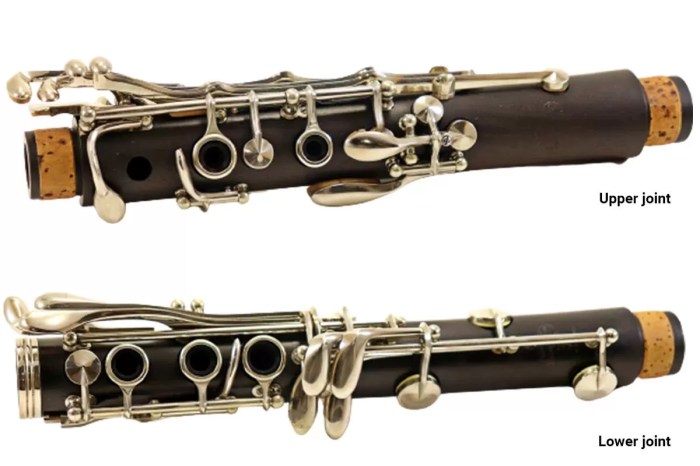
The upper joint, also known as the top joint, is a crucial component of the clarinet that connects the mouthpiece to the lower joint. It plays a significant role in producing the instrument’s distinctive sound and facilitating keywork.
Key System, Parts of the clarinet diagram
The upper joint features a complex key system that allows the player to produce different notes by covering and uncovering specific holes along the bore. The key system consists of:
- Left-hand keys:These keys are operated by the left thumb, index, and middle fingers. They cover holes on the top side of the joint.
- Right-hand keys:These keys are operated by the right thumb, index, and middle fingers. They cover holes on the bottom side of the joint.
- Trill keys:These keys are used to facilitate rapid trills between certain notes.
The precise placement and design of the key system vary depending on the type of clarinet (e.g., Bb, A, Eb). However, the general principles remain the same across all models.
Diagram
Below is a diagram of the upper joint with labeled parts:
[Insert diagram here, with labels for the key system components]
Lower Joint
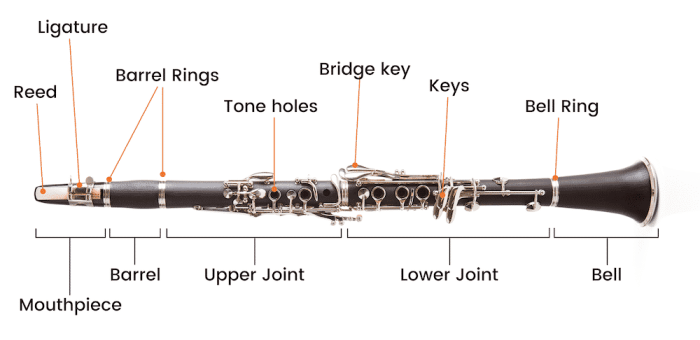
The lower joint of the clarinet is the section that connects the upper joint to the bell. It is responsible for holding the reed in place and providing the proper intonation for the instrument.The key system on the lower joint consists of the following keys:
- Left-hand little finger key:This key covers the left-hand little finger hole and is used to play notes in the lower register.
- Right-hand thumb key:This key covers the right-hand thumb hole and is used to play notes in the upper register.
- Right-hand index finger key:This key covers the right-hand index finger hole and is used to play notes in the middle register.
There are different types of lower joints available, each with its own unique sound and feel. Some of the most common types of lower joints include:
- Standard lower joint:This is the most common type of lower joint and is found on most clarinets.
- Extended lower joint:This type of lower joint is longer than the standard lower joint and provides a darker, richer sound.
- Polyphonic lower joint:This type of lower joint is made of a special material that allows for a more resonant sound.
5. Bell
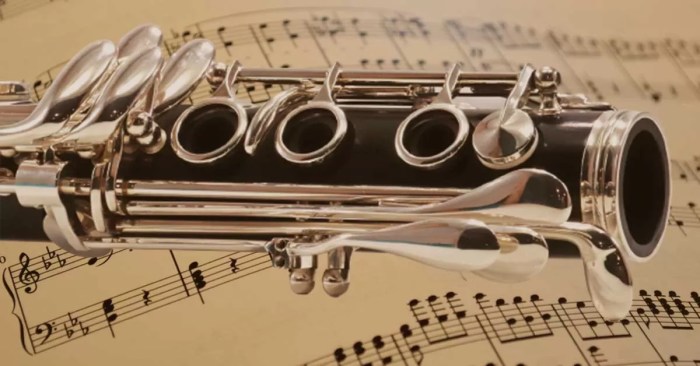
The bell is the flared end of the clarinet, and it is responsible for projecting the sound. It is typically made of metal or wood, and its shape and size can affect the tone and volume of the instrument.
The bell helps to amplify the sound waves produced by the clarinet’s reed and bore. The shape of the bell determines the direction and spread of the sound waves, and the size of the bell affects the volume of the sound.
A larger bell will produce a louder sound than a smaller bell.
Materials Used for Bells
The most common materials used to make clarinet bells are metal and wood. Metal bells are typically made of brass or silver, while wood bells are typically made of grenadilla or rosewood.
- Brass bellsare the most common type of bell used on clarinets. They produce a bright, clear sound with good projection.
- Silver bellsare less common than brass bells, but they produce a warmer, more mellow sound.
- Grenadilla bellsare made from a type of African hardwood. They produce a dark, rich sound with excellent resonance.
- Rosewood bellsare made from a type of Brazilian hardwood. They produce a bright, clear sound with good projection, similar to brass bells.
Keys and Keywork: Parts Of The Clarinet Diagram
The clarinet’s keywork is a complex system of levers and pads that allows the player to produce the instrument’s wide range of notes. The keys are arranged in groups, with each group responsible for a particular set of notes. The most common key system for the clarinet is the Boehm system, which was developed in the 19th century by the German clarinetist Hyacinthe Klosé.
The Boehm system keywork consists of 17 keys and 6 rings. The keys are arranged in three groups: the left-hand keys, the right-hand keys, and the thumb keys. The left-hand keys are responsible for the notes from low E to high C, the right-hand keys are responsible for the notes from high C# to high G, and the thumb keys are responsible for the notes from low D to low E.
| Key | Function |
|---|---|
| Left-hand keys | Produce notes from low E to high C |
| Right-hand keys | Produce notes from high C# to high G |
| Thumb keys | Produce notes from low D to low E |
| Register key | Changes the instrument’s range by an octave |
| Trill keys | Allow the player to trill between two notes |
| Articulation keys | Control the start and stop of notes |
Ligature
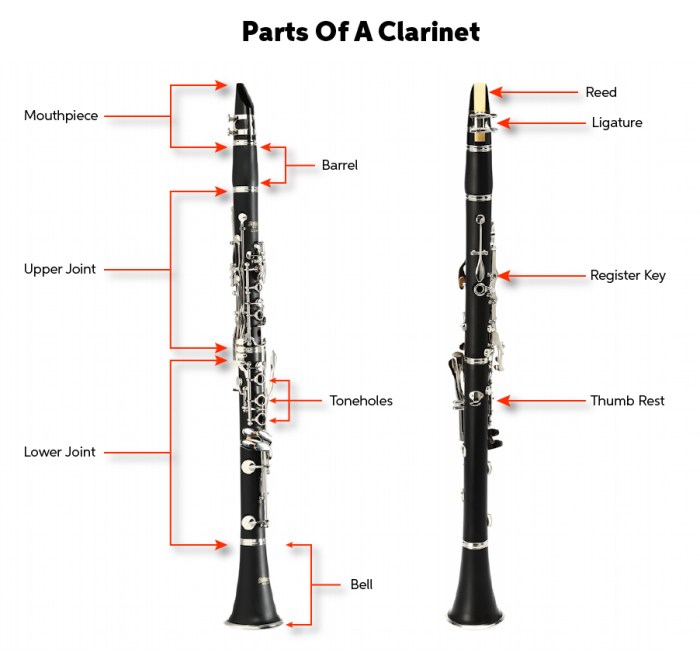
The ligature is a metal or leather band that wraps around the mouthpiece and the reed, holding them together. Its purpose is to:
- Secure the reed in place on the mouthpiece
- Provide resistance to the reed, which affects the sound of the clarinet
- Dampen vibrations in the reed, which can improve the sound quality
There are different types of ligatures available, each with its own unique characteristics:
Types of Ligatures
- Single-screw ligatures: These ligatures have a single screw that tightens the band around the mouthpiece and reed. They are easy to use and adjust, making them a popular choice for beginners.
- Double-screw ligatures: These ligatures have two screws that tighten the band around the mouthpiece and reed. They provide more precise adjustment than single-screw ligatures, but they can be more difficult to use.
- Leather ligatures: These ligatures are made of leather and are tied around the mouthpiece and reed. They provide a more traditional look and feel, but they can be more difficult to adjust than metal ligatures.
The type of ligature you use can affect the sound of your clarinet. Single-screw ligatures tend to produce a brighter sound, while double-screw ligatures produce a darker sound. Leather ligatures produce a more mellow sound.Ultimately, the best way to find the right ligature for you is to experiment with different types and see what sounds best on your clarinet.
Reed
The reed is a thin, flexible piece of material that vibrates to produce sound on the clarinet. It is located at the top of the mouthpiece and is made from a variety of materials, including cane, plastic, and synthetic materials.
When the player blows into the mouthpiece, the reed vibrates against the tip of the mouthpiece, creating a sound. The pitch of the sound is determined by the length and thickness of the reed. Thicker reeds produce lower pitches, while thinner reeds produce higher pitches.
Types of Reeds
There are three main types of reeds used on the clarinet:
- Cane reedsare made from the Arundo donax plant. They are the most common type of reed used on clarinets and produce a warm, rich sound.
- Plastic reedsare made from a variety of synthetic materials. They are more durable than cane reeds and produce a brighter sound.
- Synthetic reedsare made from a combination of natural and synthetic materials. They offer a balance between the sound quality of cane reeds and the durability of plastic reeds.
Case
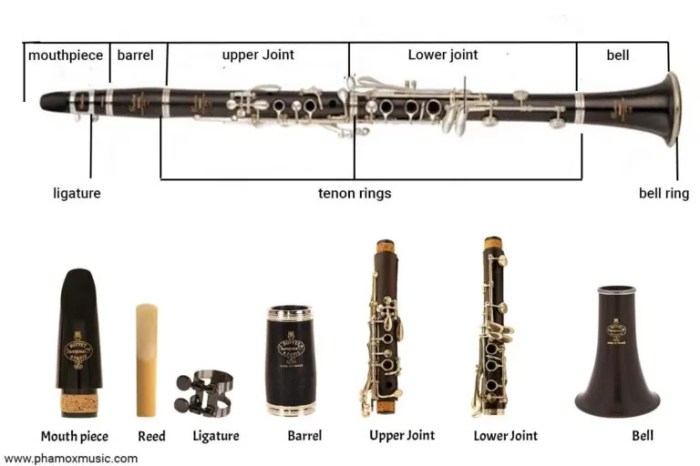
Clarinet cases are essential for protecting your instrument from damage during storage and transportation. There are several types of cases available, each with its own advantages and disadvantages.
When choosing a case, consider the following factors:
- Durability:The case should be made of durable materials that can withstand bumps and drops.
- Fit:The case should fit your clarinet snugly to prevent it from moving around and getting damaged.
- Weight:The case should be lightweight enough to carry around comfortably.
- Features:Some cases have additional features, such as compartments for accessories or shoulder straps.
Storing and Transporting a Clarinet in a Case
To store your clarinet in a case, first make sure that it is clean and dry. Then, place the clarinet in the case and secure it with the latches or straps. If your case has compartments for accessories, store them in the appropriate compartments.
When transporting your clarinet, be sure to carry it upright and avoid exposing it to extreme temperatures or humidity.
Accessories
Accessories play a crucial role in enhancing the playing experience and maintaining the clarinet’s performance. Here’s a list of essential accessories every clarinet player should consider:
-
Cleaning Supplies
Regular cleaning is essential to maintain the clarinet’s hygiene and sound quality. Cleaning supplies include:
- Swabs:Used to clean the inside of the instrument, removing moisture and debris. Consider swabs from Vandoren or BG.
- Pull-throughs:Long, thin brushes used to clean the bore of the instrument. Opt for pull-throughs from Yamaha or Leblanc.
- Cleaning cloths:Soft cloths used to wipe down the instrument’s exterior and remove fingerprints. Consider microfiber cloths from Hercules or Protec.
-
Cork Grease
Cork grease lubricates the tenons and corks on the clarinet, ensuring a smooth fit and preventing air leaks. Consider cork grease from La Tromba or Selmer.
-
Ligature
The ligature holds the reed in place on the mouthpiece. Consider ligatures from Vandoren or Rovner.
-
Case
A case protects the clarinet during storage and transportation. Consider cases from Protec or SKB.
-
Metronome
A metronome helps players maintain a steady rhythm while practicing. Consider metronomes from Wittner or Korg.
-
Tuner
A tuner helps players ensure their clarinet is in tune. Consider tuners from Peterson or Korg.
FAQ Resource
What is the function of the mouthpiece?
The mouthpiece is where the player’s breath enters the clarinet. It shapes the air into a focused stream that vibrates the reed, producing sound.
What are the different types of clarinet barrels?
Clarinet barrels vary in length and material, affecting the instrument’s overall pitch and tone. Common types include the standard barrel, extended barrel, and adjustable barrel.
How does the key system work on the clarinet?
The key system consists of a series of keys and levers that open and close holes along the clarinet’s body, changing the pitch of the notes produced.
What is the purpose of the ligature?
The ligature holds the reed in place on the mouthpiece, allowing the player to adjust its position and tension, influencing the clarinet’s sound.